His subjects leave a strong impression and draw the viewer’s gaze but is that the only appeal of his photos? Are the strong images the product of his intentions or a by-product of some emotional attraction he felt within the subjects? Is there even the need to talk about the technical aspects? With such thoughts in mind, the interview commenced exploring his first steps into photography, the production of his prints as well as his views on what is ahead.
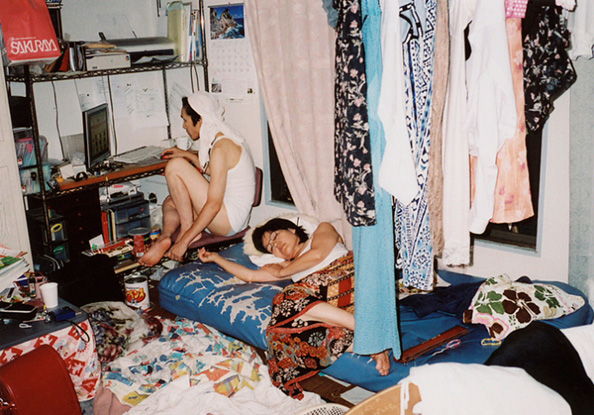
From here onwards, SPACE CADET is represented as SC, while Motoyuki Daifu is represented as MD.
SC: Until we had this chance to interview you, I had the impression that you wouldn’t talk so much about your work. By the way, how often have you been interviewed like this before?
MD: Not so much.
SC: So this will be your first proper interview then. Will you answer specifically including technical aspects too, or will you blur things out?
MD: I won’t blur things out. I’ll answer them properly. It’s just that, people frame things in complicated words, with difficult terms. That kind of thing, I can’t do.
SC: Looking at your background it says that you attended a vocational college, so you graduated from there then?
MD: Yes, I went to the Tokyo Visual Arts.
SC: The vocational college was two years?
MD: Yes. I went to night school there.
SC: Did you learn both digital and analogue methods at Tokyo Visual Arts?
MD: When I went there we learnt both. It seems they are becoming more digitalized now, when I went there last, one of the dark rooms was demolished.
SC: At the time that you were there, were the classes divided equally in half to learn digital and analogue photography?
MD: Yes, it was.
SC: At the moment do you still take pieces in analogue, or rather on film?
MD: Yes, I do.
SC: I saw that you had a Contax camera on your Twitter photo, I thought that you probably shoot with that.
MD: Recently I shoot with that (Contax G2). I used to take photos with a camera called Contax T3.
SC: Was it the same T3 that you shot the photos of your family, displayed at ‘Hitotsubo’*?
*MD took part in the 29th Hitotsubo competition in 2007, where his photos were displayed but he did not win. This periodic competition is still on-going under a new name ‘1_WALL’
MD: At the time of ‘Hitotsubo’, there were a few that I took with a single-lens reflex camera. But the lens was also Carl Zeiss. The body was YASHICA. Then, from there I changed to compact cameras and stayed with compact since.
SC: It seems like you and compact cameras are a good match. We actually brought a few things for today’s interview. Do you take multiple shots in taking the picture? Or do you take just one shot and finish there?
MD: No, I take a number of shots. Though, hey you’ve got this (referring to a zine). When did you buy it?






SC: It is the first publication of ZINEs mate.
MD: You knew about me from then?
SC: At that time, no. Hence when we bought it, we thought that this was probably it.
MD: Oh, so you bought it as a box set.
SC: Yes, 5 books in one set.
MD: And you found a weird one among them...
SC: That’s right (laughs), but at first glance we only thought what a ‘weird one’. At the time we had no information. It is not as if we checked every ‘Hitotsubo’ competitor and the like. We were left wondering what this was.
MD: It’s the first time I met someone who had it. Though I did hear they sold out.
SC: Last Silver Week* we went to New York’s Dashwood Books. They had it there.
*Silver week is a modern Japanese term referring to a string of a few public holidays that join a weekend to allow several days off-work in September.
MD: Really, they had it?
SC: Yes, as an item not-for-sale. They had it as a stock for Dashwood Books. It was displayed there open for the public to see.
MD: Last year, when I exhibited in New York, I was introduced to Dashwood Books. I told them I had a zine published and asked if they wouldn’t mind having it there.
SC: Oh, so this copy is it then.
MD: And after that Dashwood apparently contacted UTRECHT. But the zine had sold out by then.
SC: Even though you didn’t win at the ‘Hitotsubo’, suddenly people who are into photography like us began to know you from the zine and then I suppose things started moving. You’ve exhibited in New York, at that time we heard Mark Gonzales had bought something of yours. Also it seems you’ll be in New York again to publish?
MD: It seems so yes. I am working on the photo book but it is hard work.
SC: Do you feel like the time has come, has it hit you yet?
MD: More. I’d like to feel more of it. I don’t feel the hit enough.
SC: So, then what is your aim?
MD: Hmm… my aim…
SC: Would you like to work as well or do you wish that your pieces sell more?
MD: My aim is Juergen Teller (laughs).
SC: We’ve heard that you like Juergen Teller.
MD: I only like Juergen Teller (laughs).
SC: You only like him?
MD: That is how much I like him. I like the Juergen Teller’s position, doing advertisements as well as taking photos. I also like his ideas.
SC: Are you not interested in Japanese photographers that Juergen Teller likes? Didn’t Juergen Teller like Nobuyoshi Araki and Seiichi Furuya?
MD: I do like Mr. Araki and view his photos, but not so much that I collect his photo books.
SC: Do you also like Juergen Teller’s stance on fashion?
MD: Yes I do.
SC: This piece as the preface to ele-king, and the photo on Facebook of a woman lying on the bed seems like you’re taking the shot with a ‘fashion’ feel.
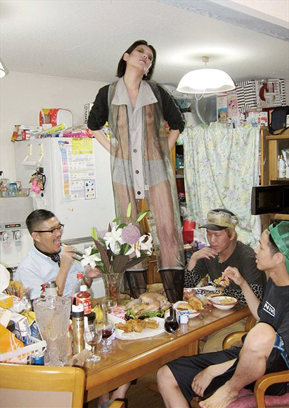
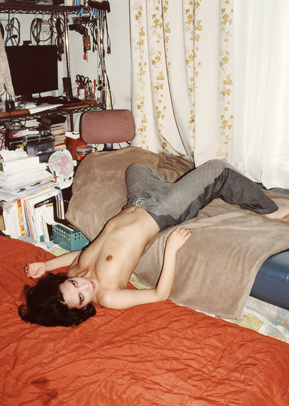
MD: Well, after I returned from New York people who are stylists or hair/make-up artists go “Let’s do something together,” and recently I’ve shot pieces here and there together and it feels fun.
SC: Is this the same model as the piece in ele-king?
MD: No this one is different. The piece for ele-king was a personal portrait piece while the one on Facebook is one that I said I would work on with stylists and hair/make-up artists. The ele-king piece was shot this summer with a G2 (the camera used as mentioned above), up until now I’ve used a compact camera indoors to shoot and it’s as if the way to take pictures has changed for me inside. It is different from the shots done before and I thought it was a pretty good piece. Then at that point I was asked to do the preface of ele-king and so I just submitted a freshly shot piece I guess. So the awareness inside of me is a bit different.
SC: Despite that you still continue to take pictures of your family?
MD: I do continue to. They are just there nearby.
SC: These photographs of your family, there’s a wonder in what will happen to them afterwards. In looking at this photo this time I think that you’re quite good at this kind of style as well.
MD: Thank you very much.
SC: To take photos of the girlfriend you’re going out with or the family that is around you, it seems like you’ll be told that you actually dare to take such photos of people you have such relations with.
MD: It’s not so much ‘on purpose’ but it just generally turns out that way. It might be my nature to (laughs) but it all begins from being strangers.
SC: In the future if you sell more or rather you have more work and you’re asked to do shoots in fashion, etc would be able to continue with it as an integral part of your work?
MD: I want to work in photography.
SC: Do you have quite a few commissions right now?
MD: No, I don’t have any.
SC: If a commission comes your way, would you work swiftly with a digital camera?
MD: I wonder. Though, if I’m asked to work digital, I’ll just have to go with it won’t I?
SC: In doing the preface to ele-king, don’t jobs come about from fashion magazines of major publications?
MD: Unless you go and sell yourself and make sure that the contact sticks, that probably doesn’t happen.
SC: I just automatically had the impression that things just flow from there. You seem to also like music.
MD: I really don’t know music. I do like classical music since its calming but I’m generally not serious about music. You know there are all those people who know the underground music scene? I don’t get it at all. If I am suggested something good then I usually just reply saying it’s good and let it slide. Like, I’ll just listen to it on Twitter or YouTube or something. I’m one not to listen hard to these things and that’s why I don’t know anything. If there is something I do know it is Yutaka Ozaki* (laughs).
*Yutaka Ozaki is a rock music artist that was greatly popular in the 1980s and 90s. He is also known for dying at the young age of 26.
SC: But (looking at the model shot in ele-king) how do you meet people like this? You’d have to be in such an industry to meet people like them. You wouldn’t really come about them in life casually…
MD: But you just do. It happens quite often. I think the subject is so important. I search for those kinds of people often.
SC: When you meet them do you approach them and talk to them?
MD: No, I don’t. It’s when I am having fun with senpai-s* or people I know and I see someone amongst the inner crowd who I think is good, I start with being the friend-of-a-friend. From there I ask.
*‘Senpai’ can literally mean a ‘senior’ but not necessarily just meaning of old age. It is a person who is more experienced in the field one is in and/or is older in school grade and/or age.
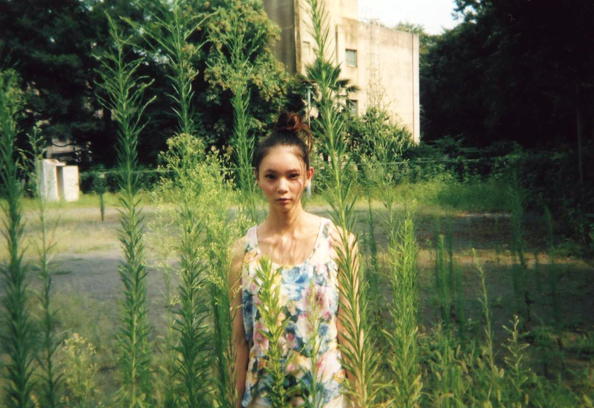
SC: In this sort of shoot, do you specify the clothing as well?
MD: I do specify, like I don’t want things like this or I don’t want them to wear a hat, etc.
SC: Hm, at that point it’s a very different way of shooting your family or ‘Lovesody’.
MD: In shooting my family and ‘Lovesody’ I do specify at times. Like ‘What if we do this…’ Though it’s not so detailed.
SC: In this one it’s something like “Stand here” isn’t it?
MD: Yup, just like that. Or just “Sit here” etc.
SC: You’re very good at composition, it’s not like you studied art is it? You learnt about the camera in college and the rest is all just instinct?
MD: I guess it is just instinct. I did like art from a long time ago. But whether the composition was good or bad was all down to feeling.
SC: In saying you liked art, does that mean you were in an art club*?
*The ‘club’ that is being referred to here is the extra-curricular activity that middle and high school students get involved in outside class. One usually sticks to one club for the entire school-life in Japan.
MD: Yes I was in the art club. I liked pictures.
SC: Like sketching and oil painting?
MD: I did do a little oil painting.
SC: Wow that was unexpected.
MD: Really? I am a super culture type*.
*Going back to the extra-curricular activities offered in schools, the genre of activities offered can be greatly divided into two: the sports type, that involves doing sports, training and competing, and the culture type, that involves no sport but everything other than sport such as chess, debates, IT, art, etc.
SC: How did you come to narrow it down to photography?
MD: That, becomes a long story, can I talk about it? (Laughs)
SC: Please, I’d love to hear.
MD: I loved pictures since I was small, I entered the art club and at the time of graduating from high school I didn’t feel like going to university so I thought of going to a vocational college. But I couldn’t imagine making a life out of drawing so to make money I thought I should go into design, then I started looking for colleges of design. At that time I for some reason decided on jewelry design, decided on the college and got recommendation letters and all I had to do was go, but just as I was ready to my parents told me, “We have no money.” I wish that they had told me earlier.
So then I couldn’t go and suddenly I was left out of society or just felt like I was thrown out outside somewhere and it was like if I wanted to go to college then I needed to save money on my own and I wasn’t prepared for this so I felt down for quite a while. But I thought if I didn’t work nothing will start so while I did part-time work for a year I thought it wasn’t design that I wanted to do, and I was thinking a lot of what to do and at some point I happened to be looking through a Men’s Non-No* and there was a tiny page showing stylists’ rooms. There was Tsuyoshi Noguchi’s ** room, in his room there were several photos hanging. I thought that one of them was really cool and wondered who it was and his name was written on the page and so I looked it up and found out it was Terry Richardson.
*Men’s Non-no is a major fashion magazine for men’s fashion of a young market published by Shueisha Inc.
**Tsuyoshi Noguchi is a well-known stylist.
SC: It wasn’t Juergen Teller, but Terry Richardson.
MD: Yes. Then I came to realize you can produce photos like this. My impression of photography changed there and photography became something to consider. Along with the fact that my dad was a cameraman.
SC: Oh so your father is a Cameraman.
MD: Yes. So I conveniently thought dad’s a cameraman, the equipment is there, it shouldn’t cost so much and the program in the college is a night school so I thought that I really could do this. That was how I thought of going into photography and entered photography.
SC: Did you like fashion to begin with?
MD: More than liking fashion I just wanted to become popular. Something like fashion=becoming popular (laughs) but I had no money so most of it is Uniqlo*. It still hasn’t changed much today…
*Uniqlo is a discount casual clothing store that has stores all over Japan as well as some cities in the world.
SC: So in magazines, it’s not as if you want to dress like what you see but you just browse through it?
MD: That’s pretty much it, just looking through and thinking ‘that looks cool’. I would not buy a thing myself.
SC: What kind of a cameraman was your father?
MD: In the past he took pictures of landscapes, though now he hardly takes any. At times he takes wedding photos or the Shichi-Go-San*.
*Shichi-Go-San is a festival in Japan where boys at age 3 or 5, girls at age 5 or 7 dress up in formal Japanese or western attire in November to visit shrines to wish for a long and healthy life. Taking photos of the children (and family) on this day or for this day is commonplace.
SC: He is a freelance cameraman?
MD: At the beginning yes. He often goes from one place to another.
SC: So you’re in the same occupation as your father.
MD: Yes I am. Heredity is scary isn’t it? (Laughs)
SC: Very unexpected. It seemed like you just suddenly transferred into photography.
MD: But until then I never thought I’d end up in photography. I didn’t really want to talk about my dad’s work when I was small, so it really did feel sudden to have ended up in photography.
SC: Even so you’re the fact about your father was a surprise. Then from there you just went straight into photography?
MD: Yes. I was very uncertain about it but I was more concerned of how I was at a pause since high school and I badly wanted to get out of that position. I was probably bloodshot eye determined.
SC: So then you learnt about using the dark room, how to do digital photography at the college and studied it all.
MD: I don’t remember much of it though (laughs).
SC: What do you do about printing now then?
MD: When I am developing the prints I do it myself, to enlarge it I bring it to the stores along with samples.
SC: When developing do you rent out dark rooms?
MD: Yes. A place in Shinjuku called PLACE M, I do it there.
SC: The ones that you brought with you today, these too?
MD: That’s Yodobashi*. Yodobashi actually comes out pretty good. There’s a part of me that thinks it’s no good being too particular.
*Yodobashi Camera is a major electronics retail store that also provides photo printing services.
SC: Do you often do it in that way? A kind of ‘please do what you will with it’?
MD: When I can control it myself, I can do this and that and be particular about it but when the situation is not like that I just leave it be. Something like hoping for a new discovery in that way.
SC: Will you continue to work in Japan from here on? We have the impression that you’re well received overseas.
MD: Yeah. Overseas would be nice.
SC: Do you think about moving your base overseas? Living over there perhaps?
MD: If I can live there I would love to. I wish I could be like that. What should I do, please give me money (laughs).
SC: In looking at you, it as if you things move swimmingly for you. Was the New York exhibit a big thing for you?
MD: Yes it was. I was a little surprised about it. At first I didn’t know what would happen. In being told ‘an exhibition overseas’ you really don’t know what it would be like and I didn’t want to hold my expectations too high but once I opened the lid I discovered that a huge number of people had gathered. In that crowd the gallery owner and a photographer Nick Haynes, who helped me curate at that the time really pushed the envelope for me and were really good to me. From there the talk about making a photo book kind of grew.
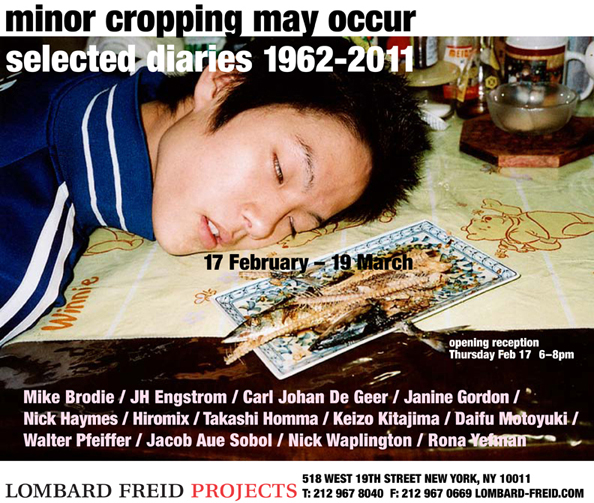
SC: How many photos do you take? Do you take pictures every day?
MD: Right now I take photos on days I decide to. I used to take pictures as a daily thing but the compact camera broke and I don’t use it now, from then I stopped carrying it around with me. Though, you can’t keep up unless you have control over these things. There is a big pile of negatives of photos that I am aware of. I used to work part-time in a photo store. I was able to develop and see the pictures I took that day there and then, but now I can’t do that and so the pile just got bigger and my mind just couldn’t keep up. The flow of blood is no good or rather it’s no good taking shots without knowing where you stand.
SC: That’s so strange. It seems like you have the energy to just keep on taking photos.
MD: There’s also the fact that the money doesn’t keep up too.
SC: When you were taking photos, how many did you take?
MD: I shot the most when I was a student, the teacher told me to take three rolls of 35mm film, about 100 shots in a day and I was aiming for that. So I aimed to finish 90 rolls in a month. But at maximum I only finished 60.
SC: That will use up a lot of money. But, did you not consider going digital?
MD: So that is why I bought the compact camera last year, but even with that I couldn’t grasp it all. Even bothering to make something like folders for that date and saving it will just make it all pile up. Also I didn’t trust digital data that much, I guess I wanted it in physical form. I preferred printing it onto 3R photo-paper and saving those since it felt like there was more substance that way.
SC: Then there are many of these 3R prints back at home?
MD: Yes. But I do throw them out, the ones I don’t need.
SC: And the ones you want as proper pieces you go and develop?
MD: Yes. I tried many methods but I feel that this fits me the best. I tried burning it onto CDs but that ended badly.
SC: The 3R prints you leave to Yodobashi, you get them printed first and then you make the selection from there and then go develop the selection properly?
MD: Yes that is how it goes. When exhibiting, lining them up allows me to somewhat understand.
SC: If only the money keeps up then that seems like the best option for things. Do you use film of a high quality as well?
MD: I use the Kodak PORTRA.
SC: Unfortunately it is integrated now isn’t it, the VC and NC.
MD: That’s right.
SC: That is going to cost.
MD: Indeed. What should I do… oh, I brought this along with me, a new zine.
SC: Thank you very much. When I first saw this I thought it was a zine of your early days, but it is actually the newest one.
MD: Yes it is.






SC: Did you do all the pagination, design and book binding yourself?
MD: I did, yes.
SC: (While looking at the zine,) We’ve asked this to Ms. Hosokura before but is everyone fine taking their clothes off for you?
MD: Yes, pretty much.
SC: Are those the people like you said before, people you got to know as a friend-of-a-friend?
MD: Yeah. Even I thought at first I couldn’t take a photo of a naked girl, I wondered how one would do it. But then despite me thinking that I was able to take shots (laughs).
SC: Very quick to conclude (laughs).
MD: Normally people would think it magical.
SC: In looking at Terry Richardson’s pieces one would think so. Very beautiful people are taken.
MD: I really thought it magical too. Though in thinking that, it happens (laughs).
SC: Why?
MD: Why indeed. But if you want to take a picture of them, all you can do is ask, “Can I take a picture of you?” right? If it’s a ‘no’ then it can’t happen. All you can do is just force them down to (laughs).
SC: But there are people that let you take pictures of them, even in Japan.
MD: There are. But maybe not so many… I’d like to take more photos like that though. But recently it’s fine even if they don’t take their clothes off.
SC: ele-king is like that isn’t it?
MD: I did ask but the answer was ‘no’.
SC: In looking at the remarks and activities of the people that surround you, I feel like you have a lot of charisma. Mark Gonzales buying your piece in New York became quite the big topic of conversation didn’t it? The fact that a piece was bought wasn’t spoken in the media but does hardly anyone know?
MD: No they don’t. I don’t even know if I can say he bought something, and at the time I didn’t even know if it was true. I heard at the after-party and I thought ‘Oh wow’.
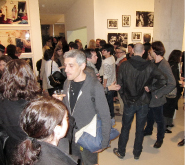
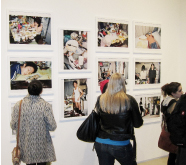
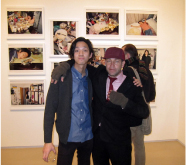
SC: Did quite a few of the other pieces get sold?
MD: If any were left unsold they will still be there. But apparently everything was sold, just wishfully thinking if all that money won’t just come my way. Sometimes fantasizing about going somewhere out there with it all.
SC: With the ‘charisma’ we mentioned earlier, I feel most creators tend to have multiple identities, them as their true selves and them as the creator on purpose. It is as if the created piece and their actual true interest seems to conflict. In following you on Twitter, I feel that you, your normal self is a part of your creation. You totally expose yourself through your tweets and through that people are drawn to you. It is not that you’re creating texts for your pieces but that the words you use and think in your daily life, the things you tweet, naturally come to connect to your pieces. I think that your followers also feel this as well.
MD: I see. That is interesting. I wonder if it’s true though since I’ve never been told I am charismatic.
SC: That is why you’re the creator and one to send out messages. You yourself may not think so but the ones that receive the messages probably think so. The fact that the person themselves aren’t aware of such intent also creates a good balance. The way you tweet without thinking too deeply.
MD: I really don’t think too hard.
SC: Normally people would worry about how they are viewed by those around.
MD: But really that doesn’t matter so much. Tweets are not dead-serious and it’s not like I am being paid to do it.
SC: Are matters of other photographers not something you think or worry about?
MD: I do really think about that. I love going to see exhibits and crave for the stimulus. I want to think ‘OH WOW’. In doing so I feel like a high. So I go to exhibits often and love seeing other people’s work.
SC: Is there an idea of where you want to head from here onwards?
MD: I wonder. But the family series influenced me a lot, and I’m troubled that I can’t get out of it but that also just began to not matter much anymore…
SC: So the family series did have an effect on you?
MD: In taking pictures my consciousness just flows this way. I struggled thinking of what to do but then again things like ‘Lovesody’ was taken in the same flow as the same family, so maybe it’s okay. But then I only get told that it’s the same piece again, and I thought that was boring.
SC: I thought it was quite different. At first when I saw the picture of your family I felt it was very stylish. What appears is very Japanese in a good way, it felt no different to what Juergen Teller was doing.
MD: But no one says such things.

SC: So then the views that don’t know ‘Japan’ such as those of foreign countries may provide you with the fairest review.
MD: In Japan it felt like pictures of the family just gets put in the ‘family-portrait’ category and people didn’t view the pictures properly.
SC: Oh and I wanted to ask how did you come up with the title ‘The family is a pubis, so I cover it with pretty panties.’?
MD: That had no title to it for a long while and it was just ‘family’ but there was a SWITCH* at home featuring Kyoko Koizumi** with an article about ‘Hanging Garden’*** and I was reading that. I really liked ‘Hanging Garden’. I’m not sure if Kyoko Koizumi said it but there was a line exactly like that. I thought ‘This is it!’ and I just used it. Kyon-Kyon** is awesome.
*SWITCH is a magazine by Switch Publishing Co., Ltd. It is known for putting the spotlight on one person or group for the entire edition.
**Kyoko Koizumi is a singer and actress. Famous in the late 1980s as a solo idol, she continues her career now mainly in acting. She is also well-known under her nickname ‘Kyon-Kyon’.
***Hanging Garden is a film that starred Koizumi, directed by Toshiaki Toyoda. Released in 2005.
SC: So it comes from Kyoko Koizumi, what a place the title came from. As we close the interview do you have any final announcements?
MD: I’ll be having a solo exhibition in New York from January 26th to March 3rd. Other than that there will be a photo book to go along with it, 300 copies.
SC: I am very much looking forward to that.
MD: For some reason there will also be an autograph-signing session (laughs). Who’s going to come to that? Kidding.
November 2011